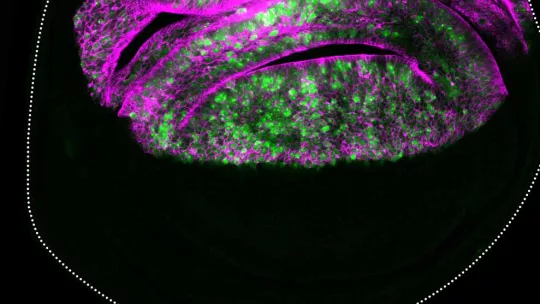Images
Researchers at IRB Barcelona and IAL Santa Fe in Argentina have found the cell-signalling factor TNFα to be critical for coordinated organ growth in the fruit fly Drosophila melanogaster.
Regulated by the tumour suppressor p53, TNFα enables the tissue to detect and reverse growth defects.
These findings allow researchers to better understand tissue development better, and they are also relevant for diseases such as cancer.
The Development and Growth Control Laboratory, led by ICREA researcher Marco Milán at the Institute for Research in Biomedicine (IRB Barcelona), has published an article in the journal PloS Genetics that identifies the signalling pathways involved in coordinating organ growth in the fruit fly Drosophila melanogaster. Together with Andres Dekanty’s group at the Instituto de Agrobiotecnología del Litoral (IAL) in Argentina, they report that the cell-signalling factor TNFα is involved in defective tissue growth signalling to neighbouring cells. Through this mechanism, neighbouring cells can reduce the speed at which they grow, thereby maintaining organ functionality.
During embryo development, the different tissues in our body grow in an ordered fashion to give rise to specific organs of predetermined shapes and sizes in specific places. However, these developmental processes are not perfect and cells sometimes can be damages. To ensure functionality of the fully formed organ, the organism must repair this damage and therefore halt organ growth during reparation. In an earlier study, the researchers observed that cells located next to damaged cells sensed this growth delay and adjusted their growth to ensure tissue functionality.
“We identified a mechanism through which the tissue can detect growth defects and respond adequately to preserve organ proportion,” say Milán and Dekanty, co-leaders of this project. Interestingly, this coordination mechanism is dependent on the tumour suppressor protein p53, which is mutated in more than 50% of all human cancers. p53 usually acts inside the cell, protecting it from damage that can ultimately lead to cancer. However, in this study the scientists uncovered an additional function: p53 also mediates communication between cells.
In this study, the researchers used the fruit fly Drosophila melanogaster to examine how neighbouring cells communicate and coordinate the shape and proportions of an organ. “Given the importance of p53 as a tumour suppressor, we addressed the mechanism p53 uses for this dialogue between cells, and we identified the genes and molecules that act downstream of p53,” explains Juan Sánchez, first author of the study. Using the fly wing as a model, the scientists found that p53 orchestrates a complex network involving the cell signalling factor TNFα (Eiger in Drosophila melanogaster), hormones, and reactive oxygen species (ROS) to ensure correct organ formation. Not only do these findings provide insights into developmental processes but they are also important for our understanding of diseases in which cell growth is deregulated, such as cancer.
This study was supported by the Ministry of Science, Innovation and Universities (previously MINECO), Spain, the European Regional Development Fund (ERDF), the National Agency for Promotion of Science and Technology (ANPCyT), Argentina, and the Universidad Nacional del Litoral (UNL), Argentina.
Reference article:
Juan A. Sanchez, Duarte Mesquita, María C. Ingaramo, Federico Ariel, Marco Milán, Andrés Dekanty.
Eiger/TNFα-mediated Dilp8 and ROS production coordinate intra-organ growth in Drosophila.
PLoS Genet (2019), DOI: 10.1371/journal.pgen.1008133
About IRB Barcelona
The Institute for Research in Biomedicine (IRB Barcelona) pursues a society free of disease. To this end, it conducts multidisciplinary research of excellence to cure cancer and other diseases linked to ageing. It establishes technology transfer agreements with the pharmaceutical industry and major hospitals to bring research results closer to society, and organises a range of science outreach activities to engage the public in an open dialogue. IRB Barcelona is an international centre that hosts 400 researchers and more than 30 nationalities. Recognised as a Severo Ochoa Centre of Excellence since 2011, IRB Barcelona is a CERCA centre and member of the Barcelona Institute of Science and Technology (BIST).






